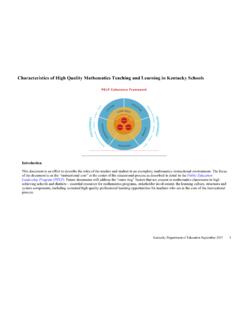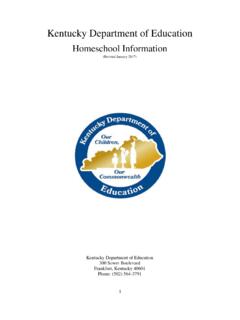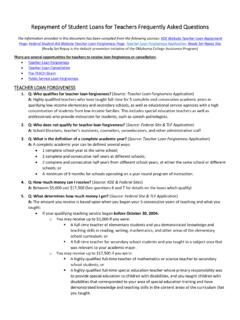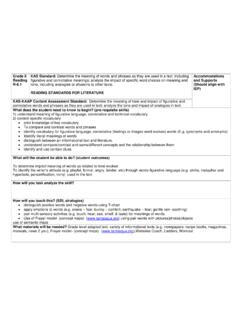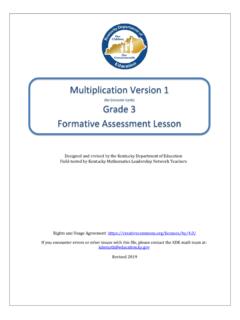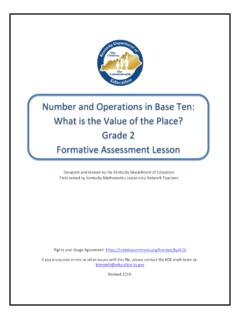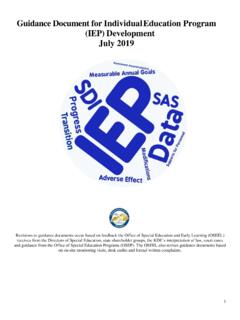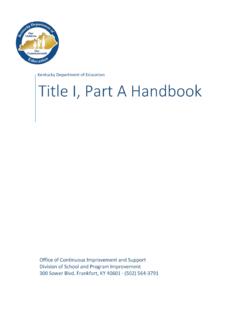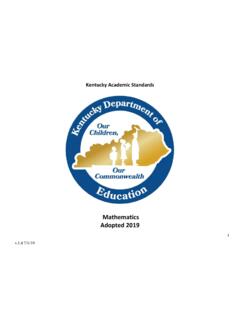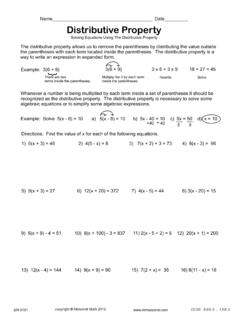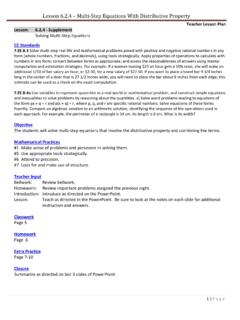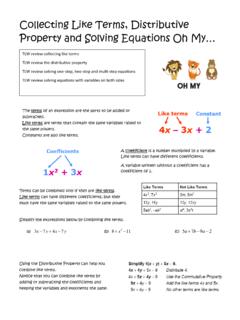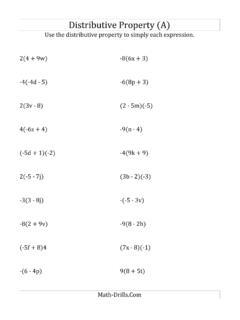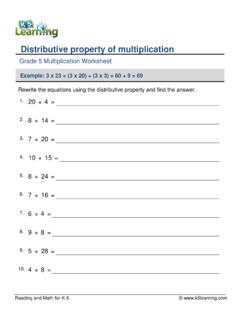Transcription of Distributive Property Multiplication - Kentucky
1 Domain: Multiplication /Geometry Distributive Property Grade: 3. Formative Assessment Lesson Designed and revised by the Kentucky Department of Education Field-tested by Kentucky Mathematics Leadership Network Teachers Rights and Usage Agreement: If you encounter errors or other issues with this file, please contact the KDE math team at: Revised 2019. Distributive Property 3rd grade This Formative Assessment Lesson is designed to be part of an instructional unit. This task should be implemented approximately two-thirds of the way through the instructional unit. The results of this task should be used to inform the instruction that will take place for the remainder of your unit. Mathematical Goals This lesson is intended to help you assess how well students are able to: Compose and decompose models to show the Distributive Property .
2 Use the Distributive Property to split a factor into benchmark numbers. Use area models, arrays, and equal group models to represent and solve Multiplication problems. Justify their choice of how to apply the Distributive Property . Kentucky Academic Standards This lesson involves mathematical content in the standards within the grade, with emphasis on: Grade 3 Operations and Algebraic Thinking Cluster: Understand properties of Multiplication and the relationship between Multiplication and division. Apply properties of operations as strategies to multiply and divide. Grade 3 Measurement and Data Cluster: Geometric measurement: understanding concepts of area and relate area to Multiplication and to addition. Relate area to the operations of Multiplication and addition. a. Find the area of a rectangle with whole-number side lengths by tiling it and show the area is the same as would be found by multiplying the side lengths.
3 B. Multiply side lengths to find areas of rectangles with whole number side lengths in the context of solving real world and mathematical problems and represent whole-number products as rectangular areas in mathematical reasoning. c. Use tiling to show in a concrete case the area of a rectangle with whole-number side lengths a and b + c is the sum of a b and a x c. Use area models to represent the Distributive Property in mathematical reasoning. d. Recognize area as additive. Find areas of figures that can be decomposed into non-overlapping rectangles by adding the areas of the non-overlapping parts, applying this technique to solve real world problems. This lesson involves a range of Standards for Mathematical Practice, with emphasis on: MP1. Make sense of problems and persevere in solving them. MP3. Construct viable arguments and critique the reasoning of others.
4 MP4. Model with mathematics. MP7. Look for and make use of structure. 2. Overall This lesson is structured in the following way: Before the lesson, students work individually on an assessment task that is designed to reveal their current understandings and difficulties. You then review/analyze their responses and create questions for students to consider/answer in order to improve their solutions. After a whole class introduction, students work in partners collaboratively on a card matching activity. Students work with a partner on collaborative discussion tasks. Throughout their work, students justify and explain their decisions to their peers. Toward the end of the lesson there is a whole class discussion. Students return to a similar task and try to improve their responses. Materials Required Each individual student will need: Pre-assessment Post assessment Dry Erase board/marker Each partner group of students will need the following resources: Card set A.
5 Card set B ready, but do not pass out Card set C ready, but do not pass out Card set D ready, but do not pass out Card set E ready, but do not pass out Record Sheet for Extension activity ready, but do not pass out until a group works through all other sets successfully. Crayons, optional Time Needed Approximately 15 minutes a day or two before the lesson for the individual assessment task, one 45 minute lesson, and then 25 minutes for a follow-up lesson for students to revisit individual assessment task. Timings given are approximated. All students may not complete all sets of cards activities and/or groups may only complete a partial section of each set. Exact timings will depend on the needs of the class. Before the Lesson Students should have knowledge on how to create Multiplication models- area models, arrays, and equal groups (this would include physical activities such as building with tiles as well as drawing representations).
6 Students should have been exposed to splitting the area models to solve Multiplication problems using the Distributive Property . Students should be able to determine two addends that can replace a factor. Students should recognize and choose benchmark numbers to solve the problem the most efficient way. The assessment focuses on several of the Standards for Mathematical Practice, with emphasis on: Construct viable arguments and critique the reasoning of others; Model with mathematics; and Look for and make use of structure. 3. Assessment Task: Distributive Property Pre-Assessment (15 minutes). Have students do this task individually in class a day or two before the formative assessment lesson. This will give you an opportunity to assess the work, and to find out the kinds of difficulties students have with it. You will be able to target your help more effectively in the follow-up lesson.
7 Depending on your class you can have them do it all at once or in small groups (they should still work individually.). Give each student a copy of the assessment task Distributive Property Pre- Assessment. A sample dialogue: Today we are going to work on a task involving the Distributive Property . This task is to help me see ways that I can help you if you are having any problems with splitting area models and arrays to solve Multiplication problems. If you are not sure about all of your answers, it is okay. We are going to do an activity that will help you improve. You will follow the directions for each question. Some ask you to draw and some ask you to explain. Some may even have more than one step.. It is important that the students are allowed to answer the questions without your assistance. If students struggle to get started ask questions that help them understand what they are being asked to do, but do not do the problem for them.
8 See the Common Misconceptions table. Students should not worry if they do not understand or cannot do everything, because in the next lesson they will engage in a similar task, which should help them. Explain to students that by the end of the next lesson, they should expect to answer questions such as these confidently. Assessing Students' Responses Collect students' responses to the task. Make notes about what their work reveals about their current levels of understanding and their different problem solving approaches. Partner students with others who displayed similar errors/misconceptions on the pre-assessment task. For this activity, the orientation of the model does not matter (Commutative Property ) and should not be considered as an error. On question #6 students may choose either answer, but it must be efficient and they must justify their reasoning.
9 We suggest that you do not score student's work. The research shows that this will be counterproductive, as it will encourage students to compare their scores, and will distract their attention from what they can do to improve their mathematics. Instead, help students to make further progress by summarizing their difficulties as a series of questions. Some questions in the Common Misconceptions table may serve as examples. These questions have been drawn from commonly identified student misconceptions. We recommend you either: write one or two questions on each student's work, or give each student a printed version of your list of questions and highlight the questions for each individual student or display a small list of questions on the board that will be of help to the majority of students or provide a few questions for each pair to answer together based on their misconceptions and need 4.
10 Below is a list of common misconceptions and questions/prompts that may be written on individual tasks, on the board or asked during the collaborative activity to help students clarify and extend their thinking. Common Misconceptions: Suggested Questions and Prompts: What information do you already know? Student has trouble getting started. What do you need to find out? How can you use the tool to show your work? How many rows and columns do you see? Student has trouble using model correctly. How can you use the rows and columns to Student has trouble drawing and counting area models help you calculate the total? and arrays. What Multiplication problem does the model show? Student cannot identify the equation that matches a What is the Multiplication problem for each given model. section of the area model or array? What two numbers can you add to make this Student does not choose two addends that add up to factor?
